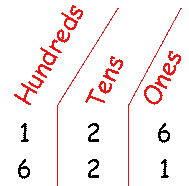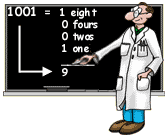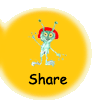|
How do we talk to machines?
|
|
|
The language we use to talk to machines is called binary notation. "Bi-" means two. Binary notation uses only two digits: The rest of the information carried in a binary message depends on the position of the 0's and 1's. This is similar to decimal notation. In decimal notation, for example, we know there's a big difference between the numbers 126 and 621. How do we know this? Because the digits (that is, the 6, the 2, and the 1) are in different positions. These positions are often called "place value positions."  It works the same way with binary numbers, except for one thing. To figure out how much each place value position is worth, you multiply by 2 (instead of 10) each time you move one more position to the left. So, here's how you would read the binary number 10110101:  How would you read these binary numbers? 11110000 10010101 10101010 Engineers and computer scientists don't usually convert from binary to decimal, though, when they are talking to computers. They convert the binary numbers to still another system of numbers called hexadecimal. |
|
|
|||||
 In our
system of numbers, we normally use decimal
notation. "Deci-" means 10. Decimal notation uses 10
digits:
In our
system of numbers, we normally use decimal
notation. "Deci-" means 10. Decimal notation uses 10
digits:




